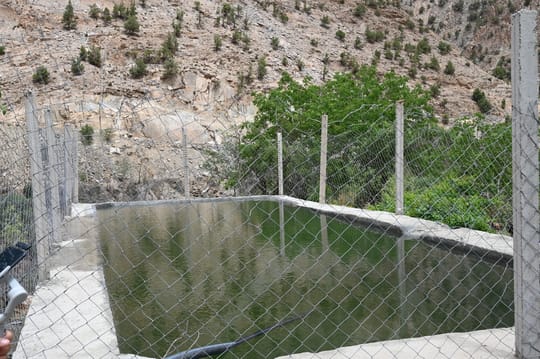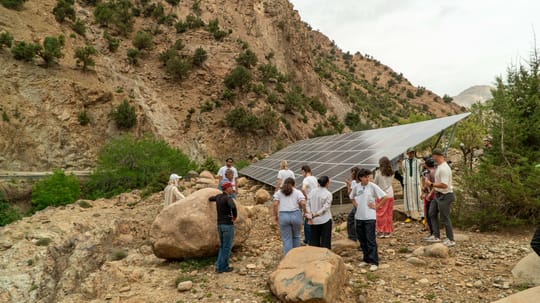At 11:11 p.m. on 8 September 2023, a magnitude 6.8 earthquake struck Morocco’s Marrakech-Safi region. The epicenter was located near the town of Ighil in the High Atlas Mountains, about 71.8 kilometers southwest of Marrakech. The earthquake killed 2,946 people and injured 5,674, with most casualties occurring in rural areas outside the city. It was the strongest recorded earthquake in the region’s history, surpassing the 1755 Meknes earthquake.
The Al Haouz and Taroudant provinces saw the highest casualties, with towns near Amizmiz and Asni nearly leveled. Over 585 schools were damaged, and many traditional homes collapsed, cutting off access to roads, electricity, and communication. Marrakech’s medina and the 12th-century Tinmel Mosque also suffered serious damage. Communities urgently needed shelter, medical care, food, and psychological support, making rapid reconstruction a top priority.
In the immediate aftermath of the disaster, the High Atlas Foundation (HAF) mobilized a large-scale emergency response. On the first day HAF started working, Mohammed—the project’s manager—described the magnitude of the crisis: “You cannot imagine the chaos in that first week,” he said. “People needed drinking water, shelter, medicine, food, clothing, psychosocial support… they needed everything.” In one High Atlas village, a local man of about fifty recounted: “We lost everything in minutes.”
Throughout the entire disaster relief period, HAF distributed over 690 tons of food and relief supplies to 69 villages in six heavily affected provinces, reaching 15,427 households. Over the following months, in collaboration with more than 15 global partners, HAF constructed 183 intermediate shelters and developed essential water infrastructure—including irrigation canals and wells—providing clean water access to over 12,597 individuals. Additionally, HAF conducted 10 psychosocial therapy workshops to support trauma recovery across the affected regions.
By comparison, the International Federation of Red Cross and Red Crescent Societies (IFRC) averaged just eight emergency shelters per week in Nepal’s hilly regions after the 2015 earthquake—whereas HAF erected 183 shelters in only three months, or about 15.2 per week, roughly 50% faster. Despite its smaller size, HAF’s rapid response and streamlined coordination outpace many larger international actors. This performance underscores the advantages of a locally rooted organization: deeper community ties, culturally tailored relief methods, far less bureaucratic overhead, and trust and partnership with regional and national government agencies prior to the earthquake.
HAF’s participatory development approach played a central role in guiding these interventions. Through community needs assessments and local forums, HAF ensured that its relief and recovery efforts aligned with residents’ immediate and long-term needs. However, participatory processes can be time-consuming and variability in local engagement and capacity also poses challenges for equitable distribution. These limitations suggest that flexible and hybrid models may be necessary for participatory approaches to function effectively in emergency contexts.

HAF integrates community empowerment and sustainable development principles into its recovery framework, focusing particularly on women’s empowerment and agricultural resilience. Through the IMAGINE empowerment workshops, women receive leadership training and psychosocial support, equipping them to take on active roles in community rebuilding. During one IMAGINE women’s empowerment session, a student shared: “I skipped one of my four annual home visits to join this workshop, but I feel so empowered being here with you.” This makes me believe that Women’s Workshops provide a safe platform for them to showcase themselves, thereby activating their subjective initiative. Many of them go on to lead agricultural cooperatives—such as fruit tree nurseries and artisanal crafts collectives—that not only contribute to economic revitalization but also promote environmental sustainability.
Nevertheless, these empowerment strategies face structural and cultural challenges. Morocco’s governance system remains relatively centralized, and local communities often depend on approval from higher-level authorities for funding and implementation. This limits the effectiveness of decentralized (or community-led) governance and can delay or constrain project execution. Moreover, although HAF encourages local ownership, communities sometimes lack the technical skills or financial resources to sustain projects, potentially increasing their burdens instead of alleviating them. Gender norms and social expectations also hinder women’s full participation, particularly in conservative rural regions.
HAF’s immediate earthquake response and long-term development strategies demonstrate the power of community-driven recovery. Looking ahead, fostering sustainable and decentralized development in Morocco will require stronger institutional partnerships and broader societal support. The work of organizations like HAF highlights the need for inclusive, participatory, and resilient frameworks in post-disaster rebuilding and beyond.
